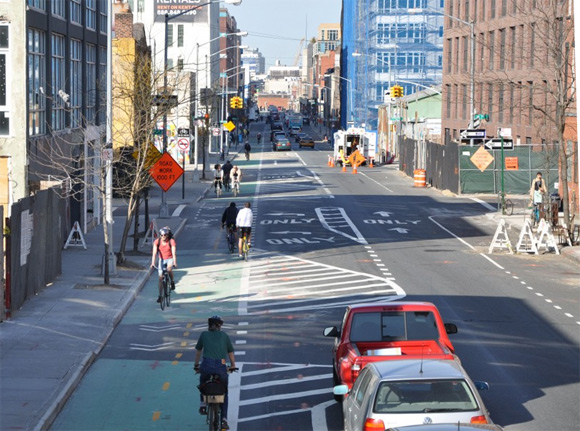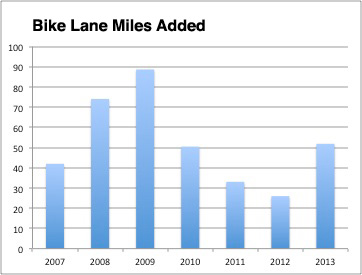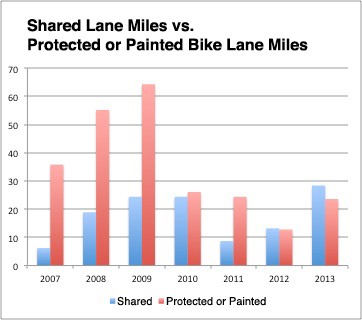
When New York City began to rapidly accelerate the expansion of its bike network in 2007 -- adding 366 miles of bike lanes over seven years -- the pent-up demand for cycling became strikingly clear.
More New Yorkers are choosing to commute by bike. Between 2009 and 2012, the number of city residents riding to work rose 26 percent, according to the Census. In Brooklyn the increase was 37 percent.
Many more people are using bikes to get to school, to meet friends, or to run errands. According to the Department of Transportation's counts, biking in the city core increased 58 percent from 2008 to 2012 [PDF]. The demand for Citi Bike -- which regularly tops 30,000 trips per day -- is another indicator that large numbers of New Yorkers will bike if it's convenient.
And none of these numbers quite capture what you can observe on a daily basis: Bicycling has entered the mainstream, and New York City has become a better city because of it.
Still, there's a lot of uncertainty about the continued expansion of the bike network, especially the addition of new protected bike lanes. While Bill de Blasio released an ambitious target to increase cycling during his mayoral campaign, the major bike projects currently in the pipeline date from the Bloomberg administration, and details about expanding the bike network are scant. The de Blasio administration has not set any specific goals for adding new bike lanes.
Will bike infrastructure play a significant role in de Blasio's transportation policy? It should. The bike network can help advance some of his signature policy goals, such as cutting traffic fatalities and improving access to housing.
Bike lanes do not make housing less expensive, but they can make less expensive neighborhoods more accessible. As the New York Times recently reported, some locations far from transit are now much more convenient:
“Your housing options change when you buy a bike and use it,” said Lyon Porter, a sales and leasing director of Town Residential, who relied heavily on a fixed-gear Dutch cruiser when living in Williamsburg several years ago and continues to cycle frequently around the city. “People get so much more for their money in this tight, compressed market,” when freed from the need to be near a train line, he said. “Your definable boundaries are different on a bike.” Without one, he said, “your map changes.”
Bike lane access is also opening up opportunities for businesses outside the Manhattan core. Tech firm Livestream made the decision to move from Chelsea to Bushwick in part because its new location makes it easy to bike to work, which the Daily News reports "could help [the company] recruit from the creative-class residents flocking to the red hot neighborhoods of North Brooklyn."
There’s no reason to think this phenomenon only applies to northwest Brooklyn. All New Yorkers need access to housing and jobs, and better bicycle infrastructure can help deliver it. But today, the bike network misses vast swaths of the city -- like pretty much the whole of Queens -- and protected lanes are especially in short supply outside of Manhattan and the Brooklyn waterfront. Because many of the neighborhoods with inadequate bike infrastructure are far from the subway, they also stand to benefit from stronger bicycle connections.
Mayor de Blasio has pledged to eliminate traffic deaths within the next 10 years. The Vision Zero Action Plan released earlier this year, however, makes only a cursory mention of bike lanes, despite their proven record of preventing deaths and injuries among pedestrians and motorists as well as cyclists.
As a candidate, de Blasio promised to grow bicycling to six percent of all trips in the city by 2020, and DOT says more bike lanes are coming. "The Mayor and our Commissioner have made clear that they are looking to expand the number of New Yorkers cycling by providing additional infrastructure that will get them where they need to go safely," said an agency spokesperson.
Currently the DOT lists 12 bike lane projects for 2014 totaling 29 miles. A one-mile stretch of buffered bike lane on Lafayette Street was recently upgraded to a protected lane, and several important bike projects are moving forward this year, including a connection on the Pulaski Bridge and further buildout of the Brooklyn Waterfront Greenway.
Still, the pace of bike lane construction is down significantly from its peak, when 162 miles were built in 2008 and 2009. Over the last two years of the Bloomberg administration, 78 miles were built, and most of those were "shared lanes" that offer little separation from speeding motorists [PDF].
It's early in the de Blasio administration, and many policy specifics have yet to be determined. But as City Hall's transportation and planning priorities take shape, it's important to incorporate bike infrastructure to achieve key goals. There are at least two major initiatives where the addition of bike lanes should be an integral strategy.
First, as the administration mulls zoning changes in 15 city neighborhoods, it needs to make good on the language in its housing plan linking new development to improvements in street safety and the bike network [PDF, page 36]. New bike lanes would serve to open up access to housing and jobs while enhancing public safety.
Second, the DOT has relied mainly on signs and signal timing so far to slow speeding traffic on dangerous arterial streets. As the city prepares more substantial redesigns that will alter the physical layout of streets, bike lanes -- especially protected bike lanes -- need to be consistently deployed to improve safety for everyone.







